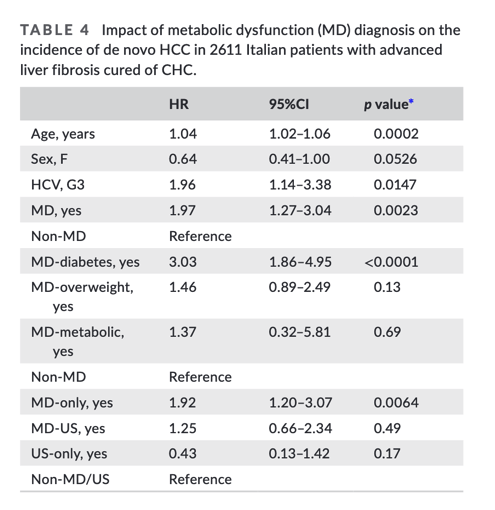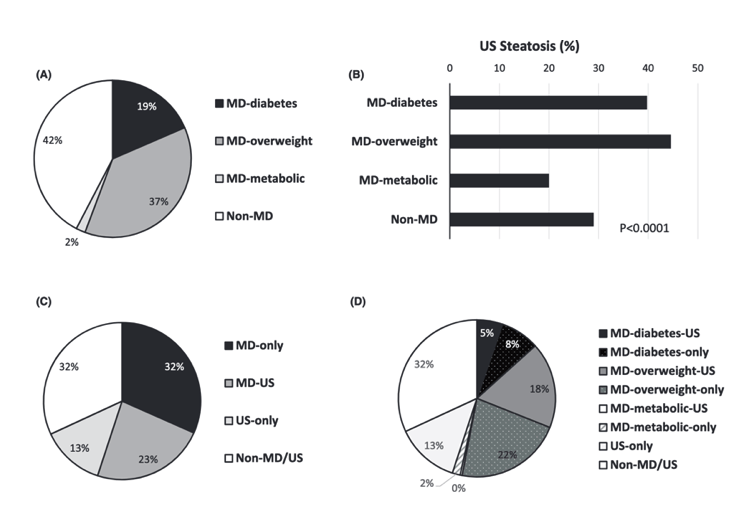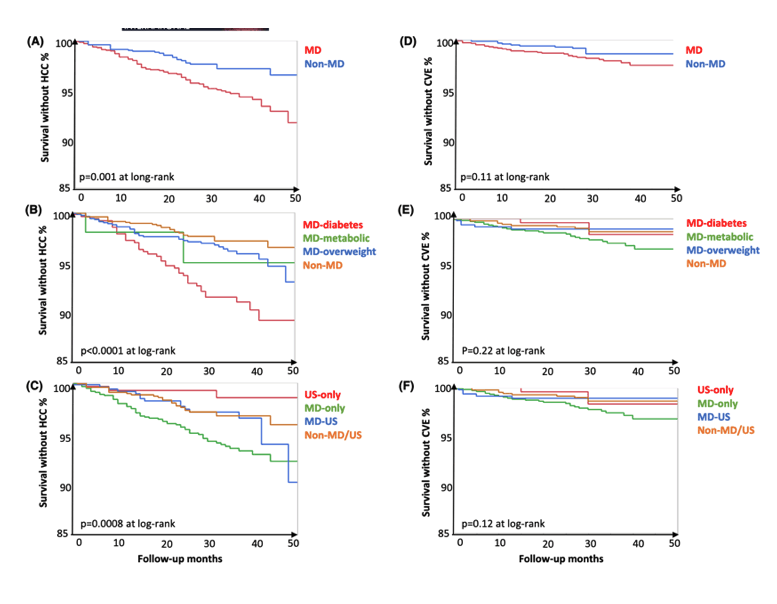| |
Metabolic dysfunction outperforms ultrasonographic steatosis to stratify hepatocellular carcinoma risk in patients with advanced hepatitis C cured with direct-acting antivirals
|
| |
| |
Download the PDF here
April 10 2023
In conclusion, by applying the MD [metabolic dysfunction] criteria in a real-life cohort of patients cured of CHC with advanced fibrosis, we found that MD is more prevalent than US and identifies more accurately individuals with advanced liver disease at risk of developing de novo HCC. MD appears more useful than US to stratify the risk of HCC in patients cured of CHC with advanced fibrosis.
The first noteworthy finding of our study was that in the setting of patients advanced CHC that we explored, MD and US diagnoses were coincident in only about one third of patients (34.3%), with MD being much more prevalent than US. This observation suggests that the prevalence of MAFLD, which in patients with cirrhosis does not require the demonstration of increased hepatic fat accumulation (e.g., US) when a positive history is reported, may be higher than previously expected.
Metabolic dysfunction is more common than ultrasonographic steatosis in patients cured of chronic hepatitis C virus (HCV) who were treated with direct-acting antivirals (DAA).1
The aim of this study was to examine the impact of MD in patients cured of chronic hepatitis C (CHC).
About one third of patients met the MD diagnosis without US evidence of US (MD-only, 32%), 23% had combined MD-US, 13% US not meeting MD criteria and another third of patients no evidence of neither MD nor US. When stratifying patients according to both the definition criteria for MD and the presence of US, the proportion of those with evidence of US was not significantly different according to the MD subgroup (p = NS; Figure 1D).
According to the definition, patients with MD alone or MD/US had higher BMI, prevalence of diabetes, dyslipidaemia and arterial hypertension than those without (p < 0.05). In this subset of patients with cirrhosis, LSM was higher in patients with MD, either with or without US, as compared than in those with US alone or without MD/US (p < 0.05).
Meeting the MD criteria was associated with an increased risk of HCC (p = 0.001; Figure 2A).
The subset at highest risk was that of patients with MD-diabetes, followed by MD-overweight and MD-metabolic (Figure 2B). When considering MD together with demonstration of US in the subset where information was available, patients with MD alone appeared at highest risk of HCC since the sustained virological response achievement, with a later catch-up of those with combined MD-US diagnosis (Figure 2C).
At Cox proportional hazard model, MD was associated with higher HCC incidence independently of age, sex and infection with genotype 3-HCV (HR 1.97, 95%CI 1.27-3.04; p = 0.0023; Table 4, upper panel). The risk was mostly increased in patients with MD-diabetes (p < 0.0001; Table 4, middle panel), and in those with MD-only (p = 0.0064; Table 4, bottom panel).
The impact of MD on HCC risk was also independent of BMI (included in the model as a continuous variable: HR 2.39, 95%CI 1.42-4.03 and p = 0.001).
Results
MD affected 58% of patients, diagnosed due to the presence of diabetes (MD-diabetes, 19%), overweight without diabetes (MD-overweight, 37%) or multiple metabolic abnormalities without overweight and diabetes (MD-metabolic, 2%).
MD was more frequent than and not coincident with US (32% MD-only, 23% MD-US and 13% US-only).
MD was associated with higher liver stiffness (p < 0.05), particularly in patients with MD-diabetes and MD-only subgroups, comprising older individuals with more advanced metabolic and liver disease (p < 0.05).
At Cox proportional hazard multivariable analysis, MD was associated with increased risk of HCC (HR 1.97, 95% CI 1.27-3.04; p = 0.0023).
Further classification according to diagnostic criteria improved risk stratification (p < 0.0001), with the highest risk observed in patients with MD-diabetes.
Patients with MD-only appeared at highest risk since the sustained virological response achievement (p = 0.008), with a later catch-up of those with combined MD-US, whereas US-only was not associated with HCC.
Conclusions
MD is more prevalent than US in patients cured of CHC with advanced fibrosis and identifies more accurately individuals at risk of developing HCC.

F I G U R E 1- Prevalence of metabolic dysfunction (MD) in patients cured of CHC with advanced fibrosis.
(A) Prevalence of MD subtypes, defined according to the diagnostic criterium met (n = 2611). (B) Prevalence of ultrasonographically detected steatosis (US) in CHC according to the presence and diagnostic criteria for MD. (C) Combined prevalence of MD and US (n = 1978). (D) Combined prevalence of MD, further classified according to the diagnostic criteria and US (n = 1978).

F I G U R E 2 Impact of metabolic dysfunction (MD) on the most frequent clinical events, namely development of de novo hepatocellular carcinoma (HCC) and cardiovascular events (CVE) in patients with available follow-up (n = 2611).
(A) Impact of MD on HCC. (B) Impact of MD stratified according to the diagnostic criteria on HCC. (C) Impact of combined MD-US on HCC (n = 1978). (D) Impact of MD on CVE. (E) Impact of MD stratified according to the diagnostic criteria on CVE. (F) Impact of combined MD-US on CVE (n = 1978).

| |
| |
| |
|
|
|